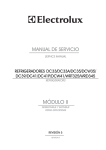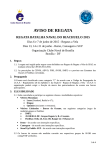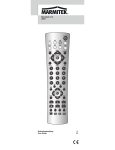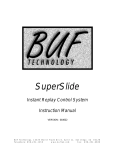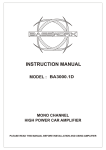Download QSC ABX Comparator User manual
Transcript
ABX Comparator USER MANUAL ON POWER D ATA UNIT A X UNIT B ENTER C A L I B R AT E TRIAL REVIEW SCROLL ABX1 ABX COMPARATOR RC ▼ ABX Comparator Double-blind listening test switcher 1 2 ABX Listening Test Comparator I. INTRODUCTION The ABX Comparator is a signal routing and measuring device that permits simple and accurate comparative listening tests of two or more power amplifiers or even line-level audio components. Using advanced microcontrollers, the ABX Comparator’s features and functions allow you to quickly set up and conduct sessions of critical listening test trials for performance evaluations. Key features include: • A built-in test tone generator and digital AC voltmeter for fast calibration of amplifier levels. • High-speed relays for fast switching between amplifiers under test. • A single pair of speaker outputs, for true accuracy. WHY USE AN ABX COMPARATOR? Comparison tests between amplifiers are often plagued with these unintended but very real inconsistencies that lead to inaccurate auditions: Unequal input sensitivities This leads to one amplifier being louder than another. Even experienced critical listeners often confuse differences in volume with differences in audio quality. Different speakers used with each amplifier The difference in frequency response between two loudspeakers, even of identical models, can often be several dB. This can easily mask differences in amplifier audio quality. Slow switching between amplifiers Your “audio memory” is short-lived. You won’t catch small sonic differences between amplifiers unless switching between them is quiet and fast (under 50 ms). Unconscious bias Even when you try to be truly unbiased, your unconscious mind often leads your conscious mind subliminally to bad conclusions, as in a “This is a Brand A amp, and this is a Brand B— which sounds better to you?” type of test. The solution is to have the listener completely unaware of which amp is which, even in the inital audition. This is called double-blind testing, and it’s the only way to get a truly unbiased result. The ABX Comparator has been specifically designed to eliminate all these errors. THE ABX TESTING PROCEDURE The letters “ABX” describe the listening factors used in double-blind testing of two amps. One amp is “A” and the other is “B,” and the two have been set up so that they put out precisely the same output levels. “X” designates the unknown factor—is it A or is it B? Thus, every time the ABX Comparator randomly selects “X,” which could be either A or B, the person judging the amps will compare it to amp A and amp B (all the while paying attention to detect audible differences between the two). The challenge then is to identify X. And this is truly “doubleblind” testing, so the listening judge doesn’t even know which amp being tested is A and which is B, but must nevertheless decide whether X is A or B. 3 One trial is not enough; even flipping a coin to decide which amp is X would yield the right result about half the time. No, it takes repeated trials, with X randomly selected each time, to get a statistically significant test. If the listening judge answers correctly in only about 50% of the trials, he or she didn’t hear any audible difference between the amps. But if far more than 50% of the answers are correct, the listener clearly discerned some audible difference. Notice that the decision made in each trial isn’t “which amp sounds better?” Instead, the goal is to identify whether the amps sound totally alike or different; deciding which is better sounding is a job best left for later. You can’t judge whether one amp sounds better than another unless you determine that they actually sound different! The ABX Comparator not only automatically and randomly selects the amplifiers, but also tracks the choices the listening judge makes in each trial. After a sequence of trials, the ABX will report how many trials and how many correct answers the judge made. II. DESCRIPTION THE ABX COMPARATOR Calibration voltmeter display Power switch LCD display UNIT A button ON D ATA POWER CALIBRATE button UNIT X button UNIT B button ENTER button UNIT A X UNIT B ENTER C A L I B R AT E TRIAL REVIEW SCROLL TRIAL button ABX1 RC ABX COMPARATOR REVIEW button SCROLL button Infrared sensor (for remote) Front panel The front panel features a power switch, a digital voltmeter display (for calibration), an alphanumeric LCD display, eight input and control buttons, and a female 8-pin DIN connector. During operation, menus, instructions, and data appear on the LCD display. Binding post signal terminals CH1 B A M P B INPUT CH1 OUTPUT CH2 CH2—LINE OUT—CH1 B A INPUT CH2 RS232 to optional computer “Combo”signal connectors A M P A CH2—LINE IN—CH1 P 1=G P 2=+ P 3=- Rear panel CH2—LINE OUT—CH1 A RS232 QSC AUDIO PRODUCTS INC. SLAVE AC power connection REPLACE FUSE WITH SAME TYPE. SEE USER'S MANUAL FOR RATING. MADE IN U.S.A. RS232 output to slave ABX The rear panel has input and output connectors, a 9-pin RS-232 port for connecting to an optional computer, and an additional RS-232 port for slaving one or more additional ABX units. 4 To route the audio signals, the ABX Comparator uses passive circuitry comprising relay switches controlled by the internal microcontroller. To avoid any possible coloration of the audio and to allow bidirectional signal flow (because testing of line-level devices uses a different hookup configuration than testing amplifiers does), no active circuitry is used in the test signal path. THE REMOTE CONTROL The handheld remote control, shown at left, communicates with the ABX via encoded infrared light. The remote duplicates four of the ABX’s front panel buttons: UNIT A, UNIT X, UNIT B, and ENTER. Although the listener could enter his or her choices for each trial using the front A X B panel buttons, it’s probably much more convenient to use the remote from a comfortable listening position. Enter The ABX can also operate without the remote control. III. SETTING UP AN AMPLIFIER TEST The diagram on the following page shows how to wire the ABX Comparator and the other components needed for a listening test of two 2-channel amplifiers. In addition to the ABX unit, you will need the following: • A high-quality line-level stereo signal source, such as a CD player. • Two 2-channel amplifiers, designated A and B, to be tested. • One pair of high-quality speakers, with a power handling capacity suitable for the amplifiers and intended listening level. You will also need the following cables: • A pair of shielded audio cables for connecting the signal source outputs to the ABX line-level inputs. One end of each cable must have a connector suitable for the source device, and the other end must have either a male 3-pin XLR or a male ¼-inch (6.3 mm) TRS connector for the ABX unit. NOTE: For best results, the signal source should have balanced outputs, and all line-level signal cabling should be balanced as well. • Another pair of shielded audio cables for connecting the ABX to Amplifier A’s inputs. One end of each cable must have a connector suitable for the amplifier’s inputs, and the other end must have either a male 3-pin XLR or a male ¼-inch (6.3 mm) TRS connector for the ABX unit. 5 Speakers Speakers CD PLAYER CH1 B A M P B INPUT CH1 OUTPUT CH2 CH2 CH2—LINE OUT—CH1 A M P A CH2—LINE IN—CH1 B A INPUT CH2—LINE OUT—CH1 A RS232 QSC AUDIO PRODUCTS INC. SLAVE P 1=G P 2=+ P 3=- REPLACE FUSE WITH SAME TYPE. SEE USER'S MANUAL FOR RATING. MADE IN U.S.A. 2 RS 32 k lin (o p n tio al) CH1 out CH2 out AMP A CH 2 in CH 1 in CH1 out CH2 out AMP B CH 2 in CH 1 in Computer (optional) ABX cabling setup for testing amplifiers • Another pair of shielded audio cables for connecting the ABX to Amplifier B’s inputs. One end of each cable must have a connector suitable for the amplifier’s inputs, and the other end must have either a male 3-pin XLR or a male ¼-inch (6.3 mm) TRS connector for the ABX unit. • A pair of two-conductor speaker cables for connecting Amplifier A’s outputs to the ABX. Prepare one end of each cable so it is suitable for the amplifier’s outputs, with either a connector or stripped wire ends, as required. The other end must have either a dual banana plug or stripped wire ends, suitable for connecting to the ABX’s binding posts labeled “AMP A.” • Another pair of two-conductor speaker cables for connecting Amplifier B’s outputs to the ABX. Prepare one end of each cable so it is suitable for the amplifier’s outputs, with either a connector or stripped wire ends, as required. The other end must have either a dual banana plug or stripped wire ends, suitable for connecting to the ABX’s binding posts labeled “AMP B.” • One pair of two-conductor speaker cables for connecting the ABX’s binding post outputs, labeled “AMP X,” to the speakers. One end must have either a dual banana plug or stripped wire ends, suitable for connecting to the ABX’s binding posts, and the other end must be suitable for connecting to the speakers’ input connection. 6 CONNECTING TO “COMBO” CONNECTORS The six Neutrik “Combo™” connectors accept either 3-pin male XLR or ¼-inch (6.3 mm) male TRS connectors. Pin 2 and tip are +; pin 3 and ring are -; pin 1 and sleeve are shield. CONNECTING TO BINDING POST TERMINALS When setting up the ABX for amp testing, it is vitally important for safety reasons that you connect the cabling between the amplifier outputs, the ABX, and the speakers correctly. Use only fully insulated stranded wire. 1. First, strip back the insulation no more than ½ inch (13 mm). 2. Insert the wire fully into the opening so that no part of the conductor is exposed, then tighten the barrel. Use a coin to tighten it, if necessary. 3. Alternately, you can use dual banana plugs. When setting up a test between two line-level devices, these binding post connectors serve as the return from the devices under test and the send to the amplifier. See the appendix for more details on testing line-level devices. IV. OPERATION TURNING THE ABX ON Connect the ABX to AC power: 100, 120, or 220–240 volts. The internal power supply automatically adjusts to the AC line voltage. Turn on the unit using the front panel switch. In the first few seconds after being turned on, the ABX’s LCD display will first display the unit model and then its firmware version information. Then it will ask you for the type of test you wish to do. For a power amp test, press the A button, then proceed to the calibration procedure below. For a test of line-level devices, press the B button and see the appendix for the test procedure. PRE-SESSION: CALIBRATION The ABX will automatically enter calibration mode after you select a power amp test from the “Select Test Type” screen. You can also force the ABX into calibration mode by pressing the CALIBRATE button on the front panel. 7 In the calibration mode, the ABX Comparator will produce a 1 volt RMS, 1 kHz tone and send it to both channels of both amplifiers in place of the audio signal input. At the same time, the digital voltmeter display will show the output level from each amplifier channel, starting with Channel 1 of Amplifier A. In Calibration Mode, however, the loudspeakers are muted, so you won’t hear the test signal. 1. Turn off the audio source—the CD player, DAT, et al—until you complete the calibration process. 2. Adjust the gain control of Channel 1 of Amplifier A until the voltmeter reads a reasonable voltage. The ideal voltage will depend on the amps under test and the loudspeakers used for the listening test. For example, a more efficient pair of speakers won’t require as much gain or power as a less efficient pair will. For most systems a good starting point would be 20.0 to 40.0 volts. NOTE: For better accuracy and easier adjustability, set the amplifier gain controls toward the upper range of settings. 3. Once you have the gain set for Amplifier A, Channel 1, take note of the voltmeter reading. You’ll want to match this voltage with the three other amplifier channels. Press ENTER. 4. Now the ABX prompts you to set the gain for Amplifier A, Channel 2. Adjust the channel’s gain control until you get the same voltmeter reading as with Channel 1, within 0.1 volt. Press ENTER. 5. Repeat step 3 for Amplifier B, Channel 1, and again for Amplifier B, Channel 2. NOTE: If one of the amplifiers under test has no gain controls, you’ll have to match the other amp to that one. After you complete calibrating all four channels, the ABX will automatically proceed to the trial mode, which is the session of actual listening trials. (However, if you are unsatisfied with or unsure about the calibration, you can press the CALIBRATE button on the front panel to go back and repeat the procedure.) READYING THE TEST SESSION Start the test session with the listening judge in a comfortable listening position in front of the speakers. For program material, use a familiar, high-quality recording, although there are many preferences and schools of thought on what constitutes suitable music for audio performance evaluations. Acoustic music is often good for revealing distortions in an amplifier, while heavy metal might tend to mask them. Synthesized bass might highlight differences in the low end. Clean, up-front vocals that sound harsh through one amp indicate probable midrange problems, particularly if they don’t sound harsh through the other amp. Use your own judgment in selecting the recording. The ABX Comparator can run up to 25 trials in a session. Afterwards, the LCD display will show how many correct answers the listening judge entered, out of how many trials, and the resulting percentage of correct answers. You can also review the results of each trial in the session. 8 THE TEST SESSION BEGINS NOTE: To preserve objectivity in the test, don’t tell the listening judge before or during the trials which amplifier is A and which is B. Otherwise, if he or she has even a slight prejudice toward or against one amp, they may try to pay attention to “does Amp X sound like Brand Z” instead of to whether the amps sound alike or different. Instruct the listening judge: 1. Each trial starts with the X, or unknown, amplifier, which could be either Amp A or Amp B. Compare its sound with that of Amp A, by pressing the A button, and to Amp B, by pressing the B button. You can switch to X by pressing the X button. You may freely switch back and forth among Amp A, Amp B, and Amp X as much as you’d like before you enter your choice. Listen carefully. Does X sound like A, or like B? 2. To register your choice with the ABX Comparator, press the button—either A or B—of the amplifier that you believe is X, the unknown. Then press ENTER. 3. The ABX will not tell you if you were right or wrong; instead, it will immediately go on to the next trial, randomly selecting which amp will now be X. In the this new trial, X might be the same ampilfier as in the preceding trial, or it might be the other amp. Don’t let your previous evaluations influence your current one. Repeat this procedure for each trial. The ABX unit switches only the amplifier outputs to the speakers, and not the audio signal to the amps. This prevents the listener from getting visual cues from the amplifiers’ front panel LEDs or meters. ENDING AND REVIEWING THE TEST SESSION You can end the test session at any time by pressing the REVIEW button on the front panel of the ABX, or you can just have the evaluator perform all 25 trials. Remember, the more trials you conduct, the more statistically significant your results will be. If you press the REVIEW button, the ABX will ask you whether you want to enter review mode. Press A if you do, but if you want to continue with more listening trials, press B, then go ahead and do some more trials. In review mode, the LCD display will show how many times the listening evaluator identified X correctly, out of how many trials, and the percentage. To view the result of each trial, press the SCROLL button. Each time you press the SCROLL button, the display will step to the result of the next trial. OBTAINING STATISTICALLY SIGNIFICANT RESULTS Given only two possibilities in each trial, a random selection of A and B, such as each selection being based on coin toss—or even just selecting the same one every time—would tend to yield correct results about 50% of the time. In a small sample, i.e., a small number of trials, the actual results may be wildly different from 50%, 9 but over an increasing number of trials will almost certainly tend to approach 50%. For example, the chances of a coin coming up heads on two successive tosses is 1 in 4; on three successive tosses, 1 in 8; on four successive tosses, 1 in 16. Getting tosses of heads ten times in a row is likely only one time in 1024. In other words, large samples tend to smooth out the aberrations of randomness that occur. Therefore, not only do you need to conduct a fair number of trials in a session, but the results have to be substantially better than 50% to mean that there is an audible difference between the units under test. The very minimum number of trials you should do in a session is ten. Out of ten trials, if the listener chose the correct amplifier seven times, he or she might have heard some difference between the two, but it’s really too inconclusive. Eight correct choices would indicate a probable audible difference between the amplifiers, with about a 95% level of confidence. Nine out of ten would be an even stronger indication. Ten out of ten would almost certainly indicate the listener heard some sonic differences between the amps, since there’s only a 1 in 1024 chance it could randomly. What we’re really after in these statistics is a high degree of confidence that the results show real conditions and not random occurrences. For example, a series of 25 trials has 33,554,432 possible combinations of right/ wrong answers, ranging from 0 correct/25 wrong, up to 25 correct/0 wrong. There are 5,200,300 possible combinations of 12 correct/13 wrong, and an identical number of possible 13 correct/12 wrong. There is only one combination of 25 correct/0 wrong, and while it is possible that a random sequence of responses could be right 25 out of 25 times, there is only a 1 in 33,554,432 chance of it happening. Therefore, we can say that there is a 33,554,431/33,554,432 (99.999997%) chance of it not happening; that would also be our level of confidence in the results: 99.999997%. We won’t be quite as picky with the listening tests; a 95% minimum level of confidence will be good enough. That is, there should be less than a 5% chance that the results can be attributable to chance. # of trials 10 11 12 13 14 15 16 17 18 19 20 21 22 23 24 25 Minimum # correct 8 8 9 9 10 11 11 12 12 13 14 14 15 15 16 17 The table on this page lists a recommended range of trials, and the minimum number of correct responses necessary to reach a 95% or better level of confidence. As you increase the number of trials, your data becomes more dependable. Notice that you need 8 of 10 but only 17 of 25 to get the same degree of confidence. So, if your listener correctly “guesses” the identity of “X” at least the minimum number of times in the session of trials, you can confidently estimate that there is an audible difference between the amplifiers under test. Of course, that may mean that one amp sounds worse than the other—maybe even the amp you favor, if you do have an interest in one brand or model over the other. On the other hand, if the listener gets fewer than the minimum number correct, it doesn’t necessarily mean that the amps are audibly indistinguishable, although they may be. It more accurately means only that you can’t confidently say there’s an audible difference. It’s not a good idea to try more than 25 trials in the same sitting with the same listener. After a while, listener fatigue sets in and it gets harder for him or her to concentrate and judge the sound quality. 10 CH1 B A M P B INPUT CH1 OUTPUT CH2 CH2—LINE OUT—CH1 B A INPUT CH2 A M P A CH2—LINE IN—CH1 CH2—LINE OUT—CH1 A P 1=G P 2=+ P 3=- RS232 QSC AUDIO PRODUCTS INC. SLAVE REPLACE FUSE WITH SAME TYPE. SEE USER'S MANUAL FOR RATING. MADE IN U.S.A. CONNECTORS AND DESCRIPTIONS LINE IN A two-channel source of high-quality audio, such as a CD player, DAT etc., connects to the audio inputs of the ABX Comparator. These inputs use “Combo” jacks which accept both XLR and ¼" TRS connectors. During the calibration step, the ABX bypasses this pair of inputs and replaces it with the 1 Vrms, 1 kHz sine wave oscillator to both channels. The ABX output is also bypassed during the calibration routine. LINE OUT A This pair of fully-balanced outputs sends audio to the Channel 1 and Channel 2 inputs of amplifier A. LINE OUT B This pair of fully-balanced outputs sends audio to the Channel 1 and Channel 2 inputs of amplifier B. AMP INPUT A Both channel outputs of amplifier A return to the ABX comparator at the two pairs of AMP A input binding posts. One pair is for Channel 1, the other for Channel 2, and they are fully balanced and isolated. AMP INPUT A Both channel outputs of amplifier A return to the ABX comparator at the two pairs of AMP A input binding posts. One pair is for Channel 1, the other for Channel 2, and they are fully balanced and isolated. OUTPUT These two pairs of binding post outputs connect to the loudspeakers used in the listening tests. These are fully balanced and isolated outputs. SLAVE This is an RS-232 port used to simultaneously drive another ABX slave unit for use in active multi-way speaker systems. This feature is planned for development at a future date. RS-232 A computer can control the ABX Comparator through the unit’s RS-232 port. Instead of the standard remote control, you can use Microsoft® Visual Basic® to create a custom PC control application. This feature is planned for development at a future date. 11 Speakers LINE-LEVEL EQUIPMENT COMPARISONS The ABX Comparator is useful for comparing line-level Speakers equipment such as CD players, preamplifiers, and other equipment, too. The setup is a little different and varied with CH1 out CH2 out CH 2 in CH 1 in this form of testing. For example, testing signal sources such as CD players and DAT recorders requires only the ABX’s LINE IN and LINE OUT connectors, but connected with the device AMP CH1 B A M P INPUT CH1 CH2—LINE OUT—CH1 B A OUTPUT CH2 B INPUT CH2 A M P A CH2—LINE IN—CH1 CH2—LINE OUT—CH1 A RS232 QSC AUDIO PRODUCTS INC. SLAVE P 1=G P 2=+ P 3=- REPLACE FUSE WITH SAME TYPE. SEE USER'S MANUAL FOR RATING. MADE IN U.S.A. 2 RS 32 inputs going to the connectors labeled LINE OUT. Use a setup lin k( A na tio CD PLAYER, DAT, ETC. l) CD PLAYER, DAT, ETC. op B as shown at right. Be sure to match levels as accurately as possible, and use identical listening program material. For line-level devices such as processors, preamps, and other units having inputs and outputs, use a setup as shown at below right. While Calibrate mode is largely intended for amplifier gain alignment, it can serve as a Computer (optional) tone generator for matching other equipment. Speakers SLEEP MODE Speakers The useful life of the LCD display may be extended by enabling the sleep mode function. Jumper J103 on the main CH1 out CH2 out PCB enables (J103 shorted) or disables (J103 open) this function. Sleep mode is factory enabled and will engage 60 minutes after the last key is pressed. CH1 B A M P B AMP INPUT CH1 OUTPUT CH2 CH 2 in CH 1 in CH2—LINE OUT—CH1 B A INPUT CH2 A M P A CD PLAYER, DAT, ETC. CH2—LINE IN—CH1 CH2—LINE OUT—CH1 A RS232 QSC AUDIO PRODUCTS INC. SLAVE P 1=G P 2=+ P 3=- REPLACE FUSE WITH SAME TYPE. SEE USER'S MANUAL FOR RATING. MADE IN U.S.A. 2 RS 32 lin CH1 A CH2 IN CH1 OUT l) LINE-LEVEL DEVICE OUT na tio IN LINE-LEVEL DEVICE op CH2 k( B ADJUSTMENTS Disconnect the AC cord before opening the cover of the ABX Comparator. The upward or downward viewing angle of the LCD display may be adjusted by trimpot XXX. The backdrop light intensity of the LCD is adjusted by trimpot VR101. If a different calibration signal level is needed, adjust trimpot VR201. The factory default is 1 Vrms. REPLACING THE FUSE To replace the fuse, first detach the AC power cord from the ABX Comparator. Then use a screwdriver to gently pry the fuseholder out of the combination fuseholder/IEC connector, as shown. The fuseholder contains two fuses; replace them with the same type: 2 amp, 250V. 12 Computer (optional) SPECIFICATIONS SPECIFICATIONS Functionality: Calibration Mode Amplifier A selectable; Channels 1 and 2 individually selectable Amplifier B selectable; Channels 1 and 2 individually selectable Calibrating Signal selected automatically Trim control: 100 mV per step. Up to 2 Vrms max. Calibrating Signal Display Range: 00.0 to 99.9 Vrms ±0.1 Vrms tolerance Trial Mode Audio signal “X” in each trial is selected randomly and automatically. Trials will begin with number “01” and go up to “25,” maximum. Judgment selections are made by pressing buttons A or B, then ENTER. The next trial will begin immediately when the ENTER button is pressed, up until trial number 25. The LCD will display the results and percentage. Review Mode Trial review will start with number “01” and go up to last trial of the session, with the ABX Comparator recalling data from memory. With each trial reviewed, the LCD will display the trial number and will identify both X and the listener’s selection. Audio Performance Audio input and output Input Stage: Mechanically balanced differential, electrically passive Differential input impedance: 200 kilohms balanced and 100 kilohms unbalanced Output stage type: Single-ended THD+N (20 Hz –20 kHz): Less than 0.05% Frequency response (20 Hz–20 kHz): +0, -0.1dB Calibrating Signal 1 kHz, 1 Vrms sine wave (level externally adjustable) Switching Relay Performance Small signal relay: Contacts rated at 1.0 A and expected electrical life at rated load approximately 100,000 contacts. Heavy duty relay: Contacts rated at 30 A and expected electrical life at rated load approximately 100,000 contacts. Controls Front: AC Switch, 8 function keys IR remote control with 4 function keys Indicators Operational / mode status: LCD display Calibration level readout: 7-segment LEDs Remote status indicators: Miniature LEDs 13 Connectors Line-level audio inputs and outputs: Neutrik “Combo” XLR female and ¼” TRS connectors Speaker-level audio inputs and outputs: “Touchproof” binding posts Control port for slave unit: HD15 female RS-232 RS-232 port for remote computer control: HD15 male Power Requirements Voltage line: 80-260 VAC (autosensing), 50–60Hz Power consumption: 40 W Physical Dimensions: 19" (48.26 cm) W × 1.75" (4.44 cm) H × 12" (30.48 cm) D © Copyright 1998 QSC Audio Products, Inc. All rights reserved. “QSC” and the QSC logo are registered with the U.S. Patent and Trademark Office. QSC Audio Products, Inc., 14 1675 MacArthur Boulevard Costa Mesa, California 92626 USA PH: (714) 754-6175 FAX: (714) 754-6174

















